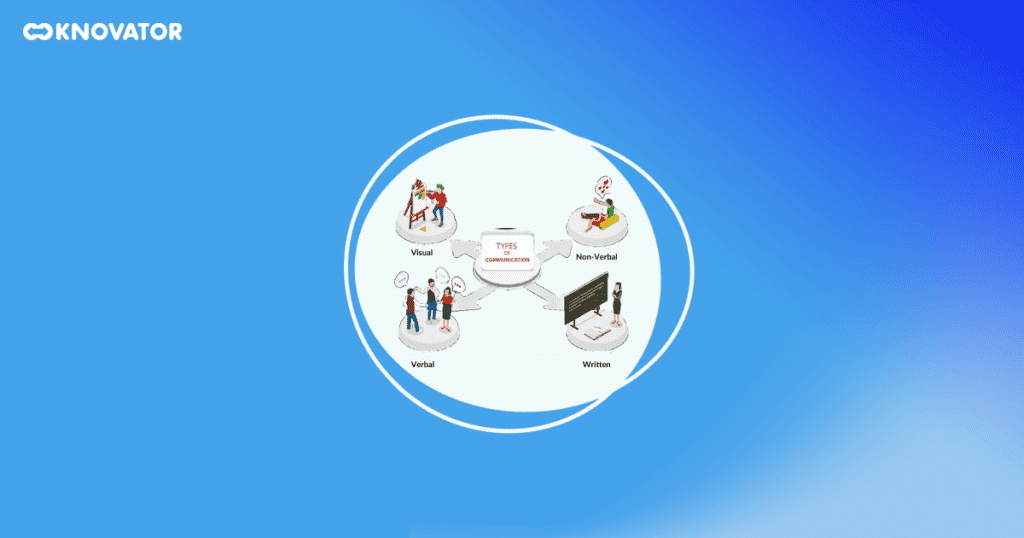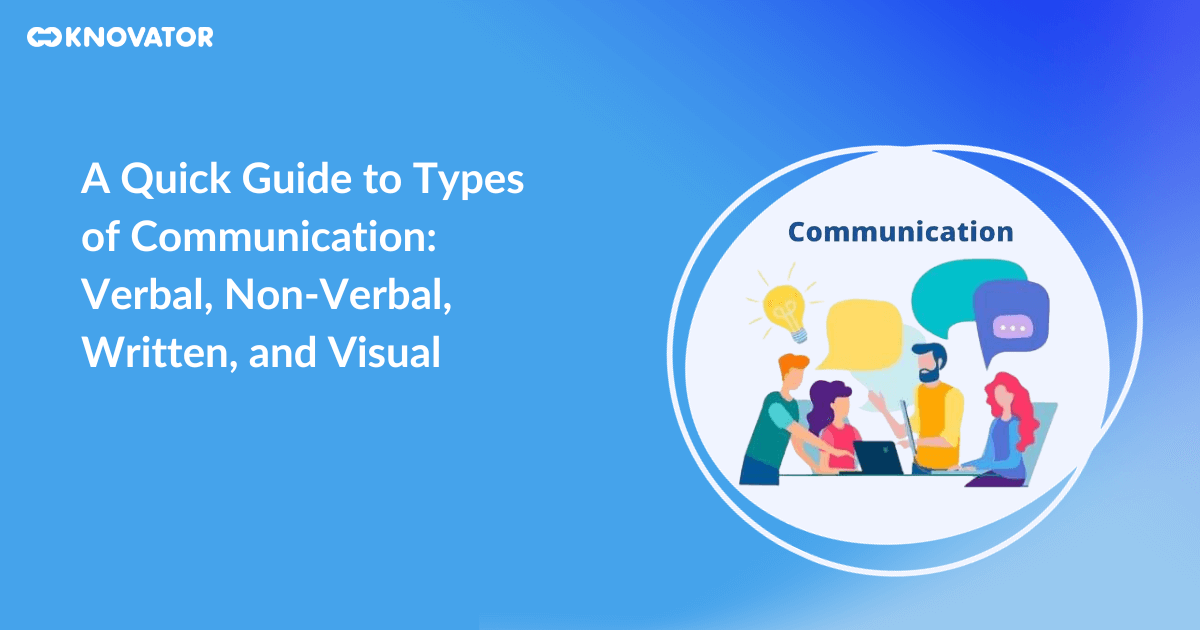Effective communication is the power behind every successful organization, relationship, or interaction. It is the channel through which ideas, emotions, information, and decisions flow. However, the communication process is much more than just speaking or writing; it includes much more.
In this blog post, we will look at the different forms of communication. Whether you are a professional looking to enhance your communication skills or simply a curious learner seeking to understand more about human interactions, this guide will provide you with valuable insights.
What are the Types of Communication?

Verbal communication means using written or spoken words to convey messages, thoughts, and ideas.
Non-Verbal Communication: Non-verbal communication doesn’t include spoken or written words.
Written Communication: This communication relies on written words to transmit information and ideas. It includes emails, letters, memos, reports, articles, and texts.
Visual Communication: Visual communication involves using graphs, charts, photographs, infographics, videos, and presentations to convey information effectively.
By understanding and utilizing these various types of communication, you can enjoy
- Effective interpersonal relationships
- Successful teamwork
- Persuasive communication
Effective communication helps individuals to express themselves, understand others, and handle challenges confidently and empathetically. It is a skill that, when honed, can lead to more fulfilling personal relationships and career advancement.
Non-Verbal Communication

1. Facial Expressions
Facial expressions help convey emotions and responses. They serve as a powerful and universal language of non-verbal communication. Our faces show various emotions, from joy and excitement to sadness, anger, fear, and surprise. These expressions are instinctive and often involuntary, allowing us to convey our innermost feelings accurately and instantaneously.
They help others understand our emotional state, enabling empathy and forming deeper connections. Facial expressions complement verbal communication when engaged in conversations. This enhances the clarity and authenticity of our messages.
2. Posture
Body language and posture significantly impact the perception of communication. This is because they provide valuable non-verbal cues that complement spoken words. People unconsciously interpret these non-verbal signals, which shapes their understanding and response to the message.
Confidence and openness are often associated with positive body language. Standing or sitting straight, maintaining eye contact, and using open gestures can convey self-assurance and sincerity. On the other hand, postures, such as crossed arms or avoiding eye contact, may make you look defensive or disinterested.
3. Gestures and Physical Touch
Gestures and touch are powerful forms of non-verbal communication. Plus, they play a significant role in conveying messages. Gestures involve hand and body movements to complement or emphasize spoken words, adding depth and clarity to the message. They enhance understanding and engagement from a simple nod of agreement to elaborate hand gestures.
Touch can convey various emotions and intentions as a non-verbal cue. A comforting hug can express empathy and support, a gentle pat on the back can convey encouragement, and a firm handshake signifies confidence and trustworthiness.
4. Eye Contact
Eye contact is a crucial aspect of non-verbal communication. It establishes trust and engagement between individuals. Maintaining appropriate and genuine eye contact during conversations shows that you are attentive and interested. This shows the other person we actively listen and value what they say.
Eye contact fosters a sense of connection and openness, making the speaker feel respected and acknowledged. It builds rapport and signals that we are present and emotionally invested in the interaction.
Verbal Communication

1. Pitch
Pitch, an essential element of vocal communication, can significantly reflect emotions and impact the message. It refers to the highness or lowness of one’s voice, and variations in pitch can convey a wide range of emotions, adding depth to the spoken words.
A high-pitched voice often indicates excitement, enthusiasm, or nervousness. On the other hand, a lower pitch shows confidence, authority, or seriousness. When speaking with a monotonous pitch, the message may seem dull or lacking emotions, making the listener lose interest.
2. Tone
Maintaining a professional and respectful tone is important in personal and professional communication. It establishes a positive and conducive interaction atmosphere, fostering trust, collaboration, and effective relationships.
A respectful tone is crucial for promoting a healthy work environment in a professional setting. It shows you consider colleagues’ opinions. And this encourages open dialog and reduces the risk of conflicts. A professional tone reflects well on one’s character and can enhance career prospects and advancement.
3. Content
Content and word choice in verbal communication holds immense significance. This is because they directly influence the message’s clarity, effectiveness, and impact. Choosing the right words and structuring the content enhances understanding and ensures the message is sent across.
Well-chosen words can evoke emotions, inspire action, and convey complex ideas easily. On the other hand, poor word selection can lead to misunderstandings, confusion, and misinterpretations.
4. Context
Understanding the context in which verbal communication occurs is essential for effective and meaningful interactions. Context refers to the surrounding circumstances, environment, and background information influencing the communication process.
The context helps interpret the intended message and prevents misunderstandings. For instance, a lighthearted comment made among friends may not be appropriate in a formal business meeting.
Cultural norms, personal relationships, and the physical setting also shape communication. Awareness of cultural differences ensures respectful and sensitive exchanges while considering the relationship dynamics. It fosters appropriate language and tone.
Written Communication

1. Structure
Structure in written communication organizes thoughts and ideas that provide clarity to the message. A well-structured piece guides readers through the content smoothly, enhancing understanding and engagement.
The clear structure ensures that the main points are presented logically, making it easier for readers to follow the flow of information. A well-organized introduction grabs attention, while a concise conclusion reinforces key takeaways.
Properly structured writing reflects professionalism and attention to detail, leaving a positive impression on readers. It helps maintain focus and avoids the risk of rambling or getting off-topic.
2. Clarity
The clarity in written communication ensures the intended message is accurately conveyed to the reader. Clear and precise writing leaves no room for misinterpretation, enhancing understanding and avoiding confusion.
When information is communicated, readers can easily grasp the main points and follow the logical flow of ideas. It means engagement and holds the reader’s attention, making the message more effective and impactful.
3. Content
The role of content in conveying the intended message is fundamental in effective communication. Content refers to the substance and information presented in a communication piece, whether written, spoken, or visual.
Well-crafted content ensures the intended message is communicated. It provides the context, supporting evidence, and relevant examples to make the message more persuasive.
4. Tone
The significance of tone in written communication cannot be overstated. It profoundly influences how the reader perceives and receives the message. Tone refers to the writer’s attitude and emotional expression conveyed through the choice of words, sentence structure, and overall style.
A positive and respectful tone fosters a warm and friendly environment, encouraging open-mindedness and receptiveness from the reader. Conversely, a negative or aggressive tone can distract the audience and impact effective communication.
Visual Communication

1. Content
Visuals play a crucial role in enhancing the understanding of a message. It provides a visual representation of information that complements written or spoken content.
Visuals such as charts, graphs, diagrams, infographics, and images can simplify intricate concepts, making them easier to understand. They help organize information, highlight key points, and establish relationships between data points.
2. Tone
Visuals significantly impact the tone of communication by adding depth, emotion, and context to the message. The choice of visuals can influence how the audience perceives the overall tone of the communication.
For instance, using bright, vibrant images or colorful graphics can create an upbeat tone, evoking joy and enthusiasm. On the other hand, using dark visuals may set a more serious or contemplative tone.
3. Use of Visuals
Using visuals effectively is crucial to enhance understanding, engagement, and impact. Here are some key considerations:
Complexity of Information: Utilize visuals when presenting complex data, concepts, or processes. Charts, graphs, and infographics can simplify information, making it more accessible to the audience.
Engagement: Incorporate visuals to capture and maintain the audience’s attention. Images and videos can create a dynamic and interactive experience, increasing engagement.
Using visuals strategically and thoughtfully can make communication more impactful, memorable, and effective in conveying the intended message.
Visual Communication in the Digital Age

Social media platforms have embraced visual content as their primary currency. Visuals are easily shareable, leading to viral trends and increased reach. The rise of platforms like YouTube has increased the demand for video content. Vloggers and content creators use visuals to tell stories, educate, and entertain.
The popularity of visual platforms has brought a change in the communication strategies for businesses and individuals alike.
Brands leverage visual storytelling to resonate with their target audience, building brand loyalty and recognition.
It is worth noting that the human brain stores visual information faster and more effectively than text. This makes visual communication efficient in conveying complex ideas and data. Infographics, for instance, offer a concise and visually appealing method to present statistics and trends.
With its ability to engage and evoke emotions and cross-cultural boundaries, visual communication is a solid way of communication and expression in the modern world. Visual communication will undoubtedly shape our communication landscape.
Get Started With Communicating Effectively
Understanding and mastering the different communication types can dramatically improve personal and professional interactions. Each form of communication has unique strengths, and using it appropriately can enhance clarity, build stronger relationships, and promote more effective information exchange.
As we navigate through our daily lives, let’s remember that communication is not just about what we say. It is also how we say it, present it, and what our body language reveals. Through increased awareness of these various forms of communication, we can truly connect with others, convey our thoughts effectively, and understand those around us better.
So, let’s start communicating effectively and thriving in all areas of life.







